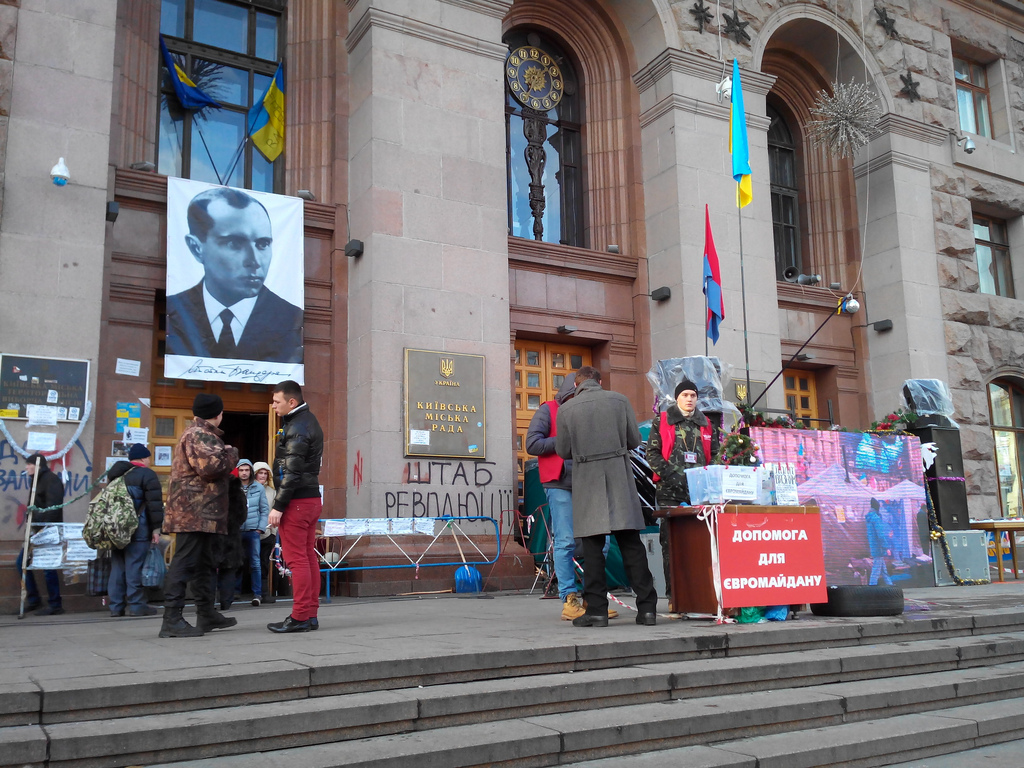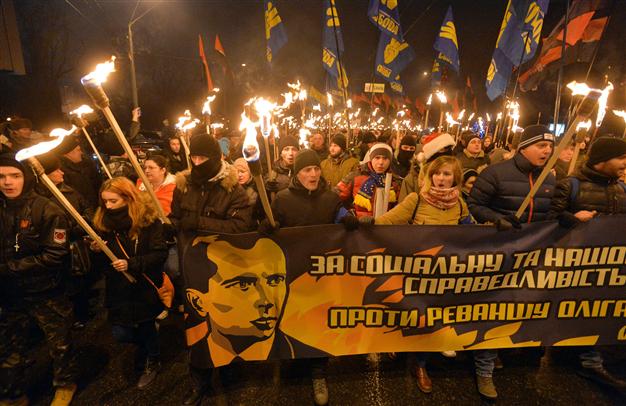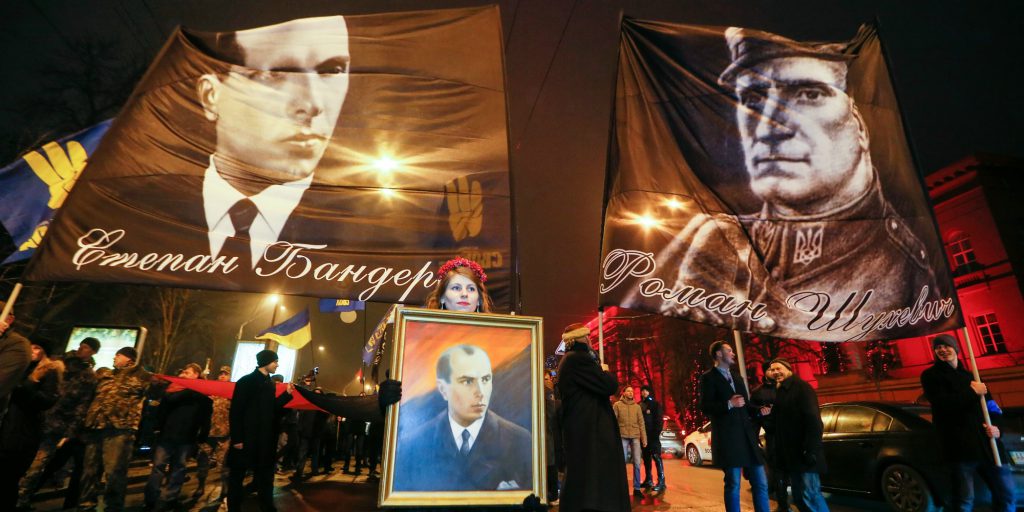
Views: 1020

During the recent years of the confrontation between Russia and Ukraine, there has been one issue where the Western mainstream press simply cannot fully ignore or reject the Russian arguments. This issue concerns the life and actions of Stepan Bandera (1909-1959) and his followers from what is known as the “Banderite” faction of the Organization of Ukrainian Nationalists (OUN, a far-right organization that took terrorist actions against Polish and Soviet officials from the 1920s to the 1950s and which is now legally protected from any criticism in Ukraine).

THE “WRONG” AND “RIGHT” VICTIMS
Because Bandera was born on January 1, 1909, celebrations of his birthday have become disgusting New Year’s rituals in Ukraine in recent years, with thousands participating in Nazi-style torch-lit marches that include shouted protests against “Putin’s Russia” and rants such as, “Jews out!” which are heard by everyone except the police. This New Year was no exception, since the current Ukrainian government under President Petro Poroshenko (who publicly identified himself as a Banderite after taking office in 2014) officially added Bandera’s 110th birthday to the list of Ukraine’s most important anniversaries. This time, there were several quiet voices of condemnation heard in Poland, Israel, and even the US. Why? In truth, torches, masks, political murders, and mob attacks against “pro-Russian” public figures are nothing new in post-Maidan Ukraine. And these things usually pose no problem for the mainstream press of the US and its allies. So, why is Bandera an exception?
The answer is ethnic, as awful as that may sound. Unlike Poroshenko with his aerial bombings of the Russian-speaking Donbass in 2014 and 2015, Bandera killed the “wrong” victims, the representatives of those nations that are valued even by the modern Western media, with its double and triple standards. In the 1930s Bandera killed Polish officials, in the 1940s his people killed civilian Jews and Polish peasants, and these are groups whose plight even the New York Times cannot ignore today. If Bandera’s infamous slogan “Death to enemies!” had been directed only against “disloyal” Russians and anti-Banderite Ukrainians (the groups currently persecuted by Poroshenko), Bandera would have been no different from his modern admirers in the Ukrainian government. But Bandera’s followers from the OUN decimated the Jewish population of Lvov and Kiev in 1941, trying to curry favor with the advancing Germans. And between 1943 and 1944, the Ukrainian Insurgent Army (UPA), taking its orders from Bandera’s OUN officers, ethnically cleansed his native Western Ukraine of ethnic Poles, killing from 70,000-100,000 of them (the infamous “slaughter of Volhynia”). The aim was to create an “ethnically pure” Ukraine before the arrival of the Red Army in late 1944. Documents published by the Polish historian Grzegorz Motyka indicate that Bandera and the OUN hoped that the Red Army would soon be replaced by Anglo-American domination. “His strategy was to clean up the house before the arrival of the real master,” Motyka concludes in his book.
THE LADY OF THE RADA VS. ISRAEL’S PRESIDENT
The American domination took another 70 years, but it did come. And now the Banderites’ (and Poroshenko’s) only historic disagreement with the West is over the infamous “ethnic cleansing,” to which Bandera’s “glorious heroes” subjected Ukraine in 1941-1944. When Israeli President Reuven Rivlin dared to raise the issue during his visit to Ukraine in 2016, he got a scolding from the vice speaker of the Ukrainian parliament (Verkhovna Rada), Irina Gerashchenko: “The Israeli president allowed himself some incorrect and undiplomatic words about the OUN’s tragic history,” Gerashchenko said at the time. “It was highly inappropriate, especially now, when Ukraine is fighting for its independence.” Gerashchenko forgot to mention the fact that Babi Yar, the burial site of some 30,000 Jews killed by German and Ukrainian Nazis in Kiev in 1941, was vandalized nine times between 2015 and 2016, according to data provided by the Ukrainian Jewish Committee.

WHY THE WEST WANTS TO FORGET, BUT CANNOT
In the immediate aftermath of the Maidan coup in 2014, the mainstream press was ready to forget even that, since an honest account of Bandera’s activities between 1939 and 1959 could rekindle memories of the undesirable parallels to the “resistance to Russian occupation” by Poroshenko’s army in the Donbass in 2014 and 2015. Between the summer of 2014 and the winter of 2015, about 10,000 people died there, victims of the aircraft and tanks sent by Poroshenko (just months earlier, the US and the EU had been unable to abide the use of truncheons by the police of the ousted president, Viktor Yanukovych). At the time, the NYT called Bandera the “Ukrainian nationalists’ hero.” Obviously, the NYT’s authors were taking their cues from the Washington Post’s Anne Applebaum, with her Banderite headline, “Nationalism is exactly what Ukraine Needs” in the once-glorious New Republic.
But here the mainstream press tried to kill off a memory that will never die — the memory of how Hitler’s East European Nazi allies participated in the destruction of the region’s Jewish population in the early 1940s. This was something not even Anne Applebaum could make people forget.
In his articles in the American press, the director of the Ukrainian Jewish Committee, Eduard Dolinsky, tried to explain to the American public that Bandera’s cult is not an isolated, unpleasant phenomenon: Stepan Bandera never acted alone, he represented a crudely nationalist ideology. Unfortunately, this ideology reigns triumphant in modern Ukraine behind the “liberal” façade displayed for the West. For example, Dolinsky notes that Poroshenko’s hypocritical speeches memorializing Jewish victims can be heard next to, say, a memorial to OUN activist Ivan Rogach, whose newspaper called Jews “the greatest enemy of the people” in 1941. “The Ukrainian leadership set itself on the course of rehabilitating anti-Semitism and introducing censorship of history,” concludes the official statement of the Simon Wiesenthal Center, an international Jewish human-rights group, famous for its work to bring Nazi criminals to justice.
THE RUSSIAN QUESTION BEHIND THE JEWISH ONE
If the West cannot afford to be completely silent about Bandera’s participation in the Holocaust, it is willingly ignoring another huge injustice that is inseparable from Bandera’s cult in modern Ukraine — the erasure of the Russian and anti-Banderite component of Ukraine’s historic memory. In 2017, Kiev’s Vatutin Avenue was renamed Bandera Avenue, resulting in an outcry in Russia and complete silence in the West. This avenue, a major thoroughfare in the Ukrainian capital, had originally been named in honor of General Nikolai Vatutin, who liberated Kiev from Nazi occupation in 1943 and died in a shootout with the OUN’s guerillas in 1944. At the time, there was no question about where America’s sympathies lay: the fight against Hitler was not yet over, and Vatutin, born in 1901 to a peasant family living immediately adjacent to the future Russian-Ukrainian border, was a useful ally for the United States. Will Bandera and his modern followers be a good replacement? Only someone with Poroshenko’s plans for Ukraine or with Anne Applebaum’s views on history could agree.

Originally published on 2019-01-15
Abouth the author: Dmitry Babich, born in Moscow, has worked for various Russian and international media outlets for more than 25 years. He is a frequent guest on BBC, Al Jazeera, RT, and CNN. His core areas of focus include Russia’s modern political history and international relations.
Source: Strategic Culture Foundation
Origins of images: Facebook, Twitter, Wikimedia, Wikipedia, Flickr, Google, Imageinjection & Pinterest.
Read our Disclaimer/Legal Statement!
Donate to Support Us
We would like to ask you to consider a small donation to help our team keep working. We accept no advertising and rely only on you, our readers, to keep us digging the truth on history, global politics and international relations.









